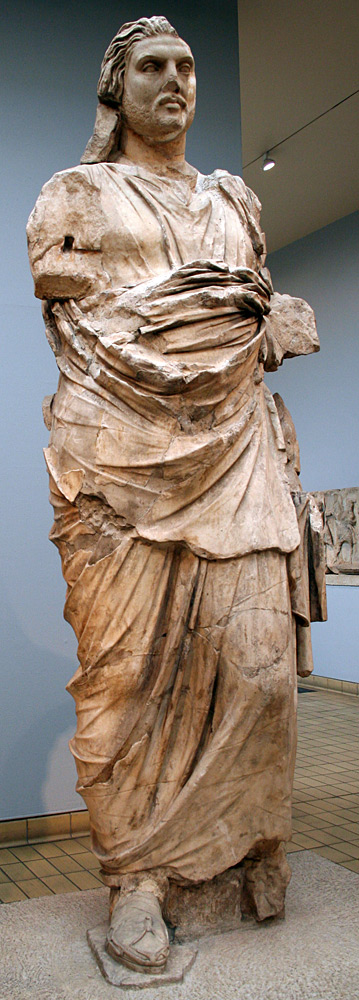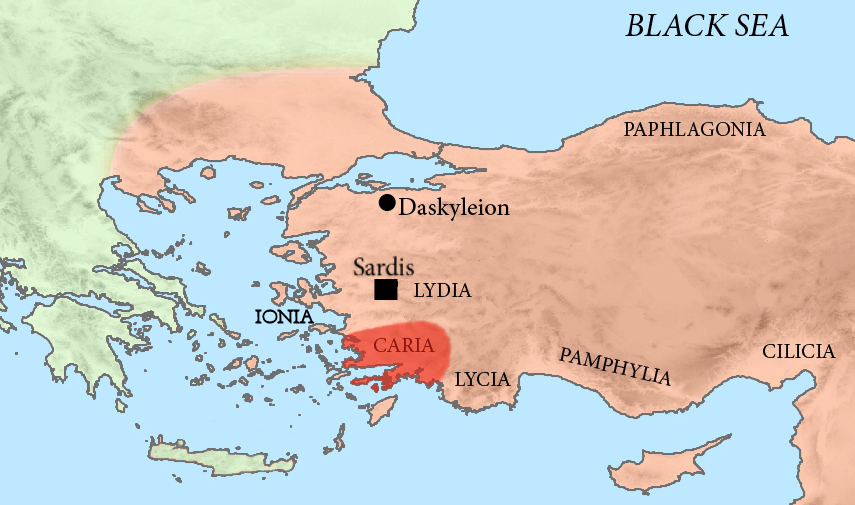Hecatomnids on:
[Wikipedia]
[Google]
[Amazon]

 The Hecatomnid dynasty or Hecatomnids were the rulers of Caria and surrounding areas BCE.
The Hecatomnids were
The Hecatomnid dynasty or Hecatomnids were the rulers of Caria and surrounding areas BCE.
The Hecatomnids were
at livius.org

 The Hecatomnid dynasty or Hecatomnids were the rulers of Caria and surrounding areas BCE.
The Hecatomnids were
The Hecatomnid dynasty or Hecatomnids were the rulers of Caria and surrounding areas BCE.
The Hecatomnids were satraps
A satrap () was a governor of the provinces of the ancient Median and Achaemenid Empires and in several of their successors, such as in the Sasanian Empire and the Hellenistic empires.
The satrap served as viceroy to the king, though with con ...
(governors) under the Achaemenid Empire
The Achaemenid Empire or Achaemenian Empire (; peo, 𐎧𐏁𐏂, , ), also called the First Persian Empire, was an ancient Iranian empire founded by Cyrus the Great in 550 BC. Based in Western Asia, it was contemporarily the largest emp ...
, although they ruled with considerable autonomy, and established a hereditary dynasty. The first satrap of the dynasty was Hecatomnus. He was appointed as the first Carian satrap of Caria in the late 390s BCE. Previously, Caria had been governed as part of Lydia
Lydia ( Lydian: 𐤮𐤱𐤠𐤭𐤣𐤠, ''Śfarda''; Aramaic: ''Lydia''; el, Λυδία, ''Lȳdíā''; tr, Lidya) was an Iron Age kingdom of western Asia Minor located generally east of ancient Ionia in the modern western Turkish prov ...
, by the satrap Tissaphernes based in Sardis
Sardis () or Sardes (; Lydian: 𐤳𐤱𐤠𐤭𐤣 ''Sfard''; el, Σάρδεις ''Sardeis''; peo, Sparda; hbo, ספרד ''Sfarad'') was an ancient city at the location of modern ''Sart'' (Sartmahmut before 19 October 2005), near Salihli, ...
. Tissaphernes was executed by Tithraustes on the orders of Artaxerxes II Memnon in 395 BCE. If Hecatomnus did not become satrap immediately upon the death of Tissaphernes, he was in office by 392 BCE, when he made war on Evagoras of Salamis on the orders of Artaxerxes II Memnon.
Hecatomnus therefore became satrap of Caria BCE. He was previously one of many minor dynasts in Caria. The Hecatomnid dynasty's seat was originally Mylasa
Milas ( grc, Μύλασα, Mylasa) is an ancient city and the seat of the district of the same name in Muğla Province in southwestern Turkey. The city commands a region with an active economy and very rich in history and ancient remains, the te ...
, in central Caria. Hecatomnus' father, Hyssaldomus, was also an independent dynast based in Mylasa, and issued coinage with Mylasan types, labelled with his initial in the Carian language
The Carian language is an extinct language of the Luwic subgroup of the Anatolian branch of the Indo-European language family. The Carian language was spoken in Caria, a region of western Anatolia between the ancient regions of Lycia and Lydia, ...
.
It was moved to Halicarnassus
Halicarnassus (; grc, Ἁλικαρνᾱσσός ''Halikarnāssós'' or ''Alikarnāssós''; tr, Halikarnas; Carian: 𐊠𐊣𐊫𐊰 𐊴𐊠𐊥𐊵𐊫𐊰 ''alos k̂arnos'') was an ancient Greek city in Caria, in Anatolia. It was located i ...
, the former seat of the Lygdamid dynasty ( BCE), by Mausolus
Mausolus ( grc, Μαύσωλος or , xcr, ���𐊠���𐊸𐊫𐊦 ''Mauśoλ'') was a ruler of Caria (377–353 BCE) and a satrap of the Achaemenid Empire. He enjoyed the status of king or dynast by virtue of the powerful position created by h ...
and Artemisia in the early 370s BCE.
Mausolus and Artemisia succeeded their father upon his death in 377 BCE.
Hecatomnus' five children succeeded him in succession. The dynasty engaged in sibling marriage, presumably to preserve royal power within the family. During the government of the Hecatomnids, both, wife like husband assumed as equally accepted rulers, and the widower of the couple would assume as the sole regnant after his or her partner deceased.
The dynasty ended in 334 BC with the conquests of Alexander the Great
Alexander III of Macedon ( grc, Ἀλέξανδρος, Alexandros; 20/21 July 356 BC – 10/11 June 323 BC), commonly known as Alexander the Great, was a king of the ancient Greek kingdom of Macedon. He succeeded his father Philip II to t ...
. Ada adopted him as her son, so that he would succeed to the rule of Caria.
The best-known monument of the dynasty is the Mausoleum
A mausoleum is an external free-standing building constructed as a monument enclosing the interment space or burial chamber of a deceased person or people. A mausoleum without the person's remains is called a cenotaph. A mausoleum may be consi ...
that Artemisia II built in honor of her husband and brother Mausolus.
After the death of Pixodarus, the last member of the Hecatomnids, Orontobates was sent by the king of Persia
Iran, officially the Islamic Republic of Iran, and also called Persia, is a country located in Western Asia. It is bordered by Iraq and Turkey to the west, by Azerbaijan and Armenia to the northwest, by the Caspian Sea and Turkmen ...
to succeed him. Orontobates, a Persian
Persian may refer to:
* People and things from Iran, historically called ''Persia'' in the English language
** Persians, the majority ethnic group in Iran, not to be conflated with the Iranic peoples
** Persian language, an Iranian language of the ...
, married the daughter of Pixodarus, and ruled from 335 to 334.
After the conquest of Alexander the Great
Alexander III of Macedon ( grc, Ἀλέξανδρος, Alexandros; 20/21 July 356 BC – 10/11 June 323 BC), commonly known as Alexander the Great, was a king of the ancient Greek kingdom of Macedon. He succeeded his father Philip II to t ...
, Ada again ruled from 334 to 326 under the Macedonian Empire
Macedonia (; grc-gre, Μακεδονία), also called Macedon (), was an ancient kingdom on the periphery of Archaic and Classical Greece, and later the dominant state of Hellenistic Greece. The kingdom was founded and initially ruled by ...
.
Members
* Hecatomnus, ruled 395–377 *Mausolus
Mausolus ( grc, Μαύσωλος or , xcr, ���𐊠���𐊸𐊫𐊦 ''Mauśoλ'') was a ruler of Caria (377–353 BCE) and a satrap of the Achaemenid Empire. He enjoyed the status of king or dynast by virtue of the powerful position created by h ...
and Artemisia II, intermarried son and daughter of Hecatomnus, ruled 377–353
* Artemisia II, daughter of Hecatomnus, wife of Mausolus
Mausolus ( grc, Μαύσωλος or , xcr, ���𐊠���𐊸𐊫𐊦 ''Mauśoλ'') was a ruler of Caria (377–353 BCE) and a satrap of the Achaemenid Empire. He enjoyed the status of king or dynast by virtue of the powerful position created by h ...
, ruled 353–351
* Idrieus, son of Hecatomnus, ruled 351–344
* Ada, daughter of Hecatomnus, wife of Idrieus, ruled 344–340 and 334–326 (under Alexander the Great
Alexander III of Macedon ( grc, Ἀλέξανδρος, Alexandros; 20/21 July 356 BC – 10/11 June 323 BC), commonly known as Alexander the Great, was a king of the ancient Greek kingdom of Macedon. He succeeded his father Philip II to t ...
)
* Pixodarus, son of Hecatomnus, ruled 340–335
:( Orontobates, Achaemenid Satrap), ruled 335-334
* Ada (second reign), ruled 334-326 under the Macedonian Empire
Macedonia (; grc-gre, Μακεδονία), also called Macedon (), was an ancient kingdom on the periphery of Archaic and Classical Greece, and later the dominant state of Hellenistic Greece. The kingdom was founded and initially ruled by ...
Family tree
Bibliography
* Simon Hornblower, ''Mausolus'', Clarendon Press, 1982, * "Hecatomnid dynastyat livius.org
References